Analysis of alternative pathway scenarios
Contents
Analysis of alternative pathway scenarios#
Aims:#
Analyse the performance of the following scenarios:
Base: Uses the hospitals’ recorded pathway statistics in SSNAP (same as validation notebook)
Speed: Sets 95% of patients having a scan within 4 hours of arrival, and all patients have 15 minutes arrival to scan and 15 minutes scan to needle.
Onset-known: Sets the proportion of patients with a known onset time of stroke to the national upper quartile if currently less than the national upper quartile (leave any greater than the upper national quartile at their current level).
Benchmark: The benchmark thrombolysis rate takes the likelihood to give thrombolysis for patients scanned within 4 hours of onset from the majority vote of the 30 hospitals with the highest predicted thrombolysis use in a standard 10k cohort set of patients. These are from Random Forests models.
Combine Speed and Onset-known
Combine Speed and Benchmark
Combine Onset-known and Benchmark
Combine Speed, Onset-known and Benchmark
The analysis will be at a global level (all hospitals together) as well as demonstrating analysis at a hospital level.
Load libraries#
import matplotlib.pyplot as plt
import numpy as np
import pandas as pd
from scipy import stats
from matplotlib.ticker import (MultipleLocator, FormatStrFormatter)
Load data#
# Scenario results
results = pd.read_csv('./output/scenario_results.csv')
# Pathway performance paramters used in scenarios
performance_base = pd.read_csv('./output/performance_base.csv')
performance_speed = pd.read_csv('./output/performance_speed.csv')
performance_onset = pd.read_csv('./output/performance_onset.csv')
performance_speed_onset = pd.read_csv('./output/performance_speed_onset.csv')
performance_speed_benchmark = \
pd.read_csv('./output/performance_speed_benchmark.csv')
performance_onset_benchmark = \
pd.read_csv('./output/performance_onset_benchmark.csv')
performance_speed_onset_benchmark = \
pd.read_csv('./output/performance_speed_onset_benchmark.csv')
performance_base
| stroke_team | thrombolysis_rate | admissions | 80_plus | onset_known | known_arrival_within_4hrs | onset_arrival_mins_mu | onset_arrival_mins_sigma | scan_within_4_hrs | arrival_scan_arrival_mins_mu | arrival_scan_arrival_mins_sigma | onset_scan_4_hrs | eligable | scan_needle_mins_mu | scan_needle_mins_sigma | |
|---|---|---|---|---|---|---|---|---|---|---|---|---|---|---|---|
| 0 | AGNOF1041H | 0.154839 | 671.666667 | 0.425459 | 0.635236 | 0.681250 | 4.576874 | 0.557598 | 0.965596 | 1.665700 | 1.497966 | 0.935867 | 0.388325 | 3.669602 | 0.664462 |
| 1 | AKCGO9726K | 0.158892 | 1143.333333 | 0.395658 | 0.970845 | 0.428829 | 4.625486 | 0.597451 | 0.955882 | 2.834183 | 0.999719 | 0.908425 | 0.419355 | 2.904479 | 0.874818 |
| 2 | AOBTM3098N | 0.085885 | 500.666667 | 0.485470 | 0.619174 | 0.629032 | 4.603918 | 0.584882 | 0.935043 | 3.471419 | 1.254744 | 0.846435 | 0.267819 | 3.694918 | 0.518929 |
| 3 | APXEE8191H | 0.098634 | 439.333333 | 0.515679 | 0.716237 | 0.608051 | 4.590357 | 0.496452 | 0.966899 | 3.312930 | 0.714465 | 0.904505 | 0.258964 | 3.585094 | 0.751204 |
| 4 | ATDID5461S | 0.090689 | 275.666667 | 0.533546 | 0.573156 | 0.660338 | 4.427826 | 0.591373 | 0.878594 | 4.125690 | 0.549301 | 0.865455 | 0.315126 | 3.497262 | 0.608126 |
| ... | ... | ... | ... | ... | ... | ... | ... | ... | ... | ... | ... | ... | ... | ... | ... |
| 127 | YPKYH1768F | 0.105193 | 250.333333 | 0.321767 | 0.585885 | 0.720455 | 4.436404 | 0.569248 | 0.952681 | 3.779215 | 0.872809 | 0.844371 | 0.305882 | 3.982100 | 0.683223 |
| 128 | YQMZV4284N | 0.104186 | 358.333333 | 0.508511 | 0.945116 | 0.462598 | 4.664536 | 0.494740 | 0.948936 | 3.574735 | 0.912298 | 0.798206 | 0.308989 | 3.285165 | 0.463749 |
| 129 | ZBVSO0975W | 0.081602 | 449.333333 | 0.442130 | 0.465134 | 0.688995 | 4.562051 | 0.510524 | 0.972222 | 2.860226 | 0.990966 | 0.930952 | 0.273657 | 3.606046 | 0.575788 |
| 130 | ZHCLE1578P | 0.112647 | 796.000000 | 0.484694 | 0.733668 | 0.671233 | 4.606557 | 0.546648 | 0.949830 | 3.306916 | 0.842940 | 0.892569 | 0.262788 | 3.276043 | 0.795401 |
| 131 | ZRRCV7012C | 0.063058 | 597.333333 | 0.469504 | 0.779576 | 0.504653 | 4.636283 | 0.485394 | 0.977305 | 3.743456 | 0.662710 | 0.851959 | 0.189097 | 3.261270 | 0.803624 |
132 rows × 15 columns
Collate key results#
Collate key results together in a DataFrame.
# Add admission numbers to results
admissions = performance_base[['stroke_team', 'admissions']]
results = results.merge(
admissions, how='left', left_on='stroke_team', right_on='stroke_team')
# Calculate numbers thrombolysed
results['thrombolysed'] = \
results['admissions'] * results['Percent_Thrombolysis_(mean)'] / 100
# Calculate additional good outcomes
results['add_good_outcomes'] = (results['admissions'] *
results['Additional_good_outcomes_per_1000_patients_(mean)'] / 1000)
# Get key results
key_results = pd.DataFrame()
key_results['stroke_team'] = results['stroke_team']
key_results['scenario'] = results['scenario']
key_results['admissions'] = results['admissions']
key_results['thrombolysis_rate'] = results['Percent_Thrombolysis_(mean)']
key_results['additional_good_outcomes_per_1000_patients'] = \
results['Additional_good_outcomes_per_1000_patients_(mean)']
key_results['patients_receiving_thrombolysis'] = results['thrombolysed']
key_results['add_good_outcomes'] = results['add_good_outcomes']
# Remove same_patient_characteristics as not needed here
mask = key_results['scenario'] != 'same_patient_characteristics'
key_results = key_results[mask]
key_results
| stroke_team | scenario | admissions | thrombolysis_rate | additional_good_outcomes_per_1000_patients | patients_receiving_thrombolysis | add_good_outcomes | |
|---|---|---|---|---|---|---|---|
| 0 | AGNOF1041H | base | 671.666667 | 15.20 | 12.76 | 102.093333 | 8.570467 |
| 1 | AKCGO9726K | base | 1143.333333 | 14.91 | 13.21 | 170.471000 | 15.103433 |
| 2 | AOBTM3098N | base | 500.666667 | 7.80 | 5.67 | 39.052000 | 2.838780 |
| 3 | APXEE8191H | base | 439.333333 | 10.40 | 7.59 | 45.690667 | 3.334540 |
| 4 | ATDID5461S | base | 275.666667 | 9.17 | 6.28 | 25.278633 | 1.731187 |
| ... | ... | ... | ... | ... | ... | ... | ... |
| 1051 | YPKYH1768F | speed_onset_benchmark | 250.333333 | 22.20 | 23.54 | 55.574000 | 5.892847 |
| 1052 | YQMZV4284N | speed_onset_benchmark | 358.333333 | 13.51 | 12.02 | 48.410833 | 4.307167 |
| 1053 | ZBVSO0975W | speed_onset_benchmark | 449.333333 | 21.12 | 20.10 | 94.899200 | 9.031600 |
| 1054 | ZHCLE1578P | speed_onset_benchmark | 796.000000 | 13.89 | 12.82 | 110.564400 | 10.204720 |
| 1055 | ZRRCV7012C | speed_onset_benchmark | 597.333333 | 12.25 | 11.22 | 73.173333 | 6.702080 |
1056 rows × 7 columns
key_results.to_csv('./output/key_scenario_results.csv', index=False)
Overall results#
columns = ['admissions', 'patients_receiving_thrombolysis', 'add_good_outcomes']
summary_stats = key_results.groupby('scenario')[columns].sum()
summary_stats['percent_thrombolysis'] = (100 *
summary_stats['patients_receiving_thrombolysis'] / summary_stats['admissions'])
summary_stats['add_good_outcomes_per_1000'] = (1000 *
summary_stats['add_good_outcomes'] / summary_stats['admissions'])
# Re-order
order = {'base': 1, 'speed': 2, 'onset': 3, 'benchmark': 4, 'speed_onset': 5,
'speed_benchmark': 6, 'onset_benchmark':7, 'speed_onset_benchmark': 8,
'same_patient_characteristics': 9}
df_order = [order[x] for x in list(summary_stats.index)]
summary_stats['order'] = df_order
summary_stats.sort_values('order', inplace=True)
# Select cols of interest
summary_stats = summary_stats[['percent_thrombolysis', 'add_good_outcomes_per_1000']]
base_thrombolysis = summary_stats.loc['base']['percent_thrombolysis']
summary_stats['Percent increase thrombolysis'] = (100 * (
summary_stats['percent_thrombolysis'] / base_thrombolysis -1))
base_add_good_outcomes = summary_stats.loc['base']['add_good_outcomes_per_1000']
summary_stats['Percent increase good_outcomes'] = (100 * (
summary_stats['add_good_outcomes_per_1000'] / base_add_good_outcomes -1))
summary_stats = summary_stats.round(2)
summary_stats.to_csv('./output/summary_net_results.csv')
summary_stats
| percent_thrombolysis | add_good_outcomes_per_1000 | Percent increase thrombolysis | Percent increase good_outcomes | |
|---|---|---|---|---|
| scenario | ||||
| base | 11.60 | 9.40 | 0.00 | 0.00 |
| speed | 12.34 | 11.86 | 6.37 | 26.13 |
| onset | 13.67 | 11.09 | 17.86 | 17.87 |
| benchmark | 14.51 | 11.70 | 25.05 | 24.36 |
| speed_onset | 14.52 | 13.98 | 25.16 | 48.63 |
| speed_benchmark | 15.43 | 14.82 | 33.01 | 57.59 |
| onset_benchmark | 17.20 | 13.87 | 48.32 | 47.53 |
| speed_onset_benchmark | 18.27 | 17.57 | 57.54 | 86.82 |
fig = plt.figure(figsize=(10,7))
ax1 = fig.add_subplot(121)
x = list(summary_stats.index)
y1 = summary_stats['percent_thrombolysis'].values
ax1.bar(x,y1)
ax1.set_ylim(0,20)
plt.xticks(rotation=90)
plt.yticks(np.arange(0,22,2))
ax1.set_title('Thrombolysis use (%)')
ax1.set_ylabel('Thrombolysis use (%)')
ax1.set_xlabel('Scenario')
ax1.grid(axis = 'y')
ax2 = fig.add_subplot(122)
x = list(summary_stats.index)
y1 = summary_stats['add_good_outcomes_per_1000'].values
ax2.bar(x,y1, color='r')
ax2.set_ylim(0,20)
plt.xticks(rotation=90)
plt.yticks(np.arange(0,22,2))
ax2.set_title('Additional good outcomes\nper 1,000 admissions')
ax2.set_ylabel('Additional good outcomes\nper 1,000 admissions')
ax2.set_xlabel('Scenario')
ax2.grid(axis = 'y')
plt.tight_layout(pad=2)
plt.savefig('./output/global_change.jpg', dpi=300)
plt.show()
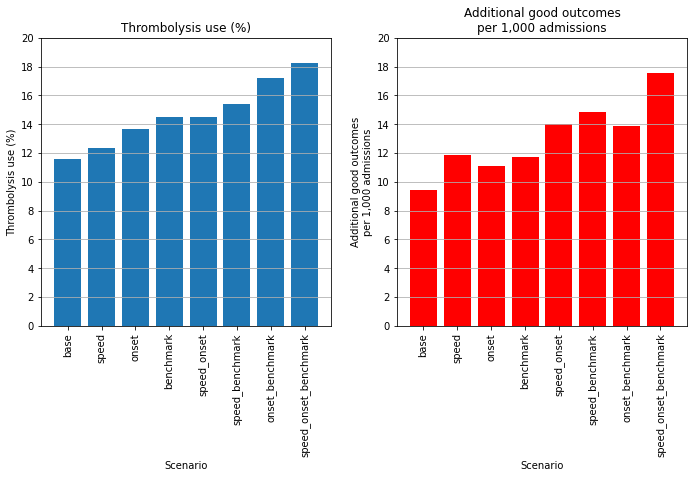
Plot changes at each hospital#
def compare_plot(base_rx, test_rx, base_benefit, test_benefit, name):
# Set up sublot
fig, ax = plt.subplots(1,2, figsize=(10,6))
# Thrombolysis use
x = base_rx
y = test_rx
for i in range(len(x)):
if y[i] >= x[i]:
ax[0].plot([x[i],x[i]],[x[i],y[i]],'g-o', alpha=0.6)
else:
ax[0].plot([x[i],x[i]],[x[i],y[i]],'r-o', alpha=0.6)
ax[0].set_xlim(0)
ax[0].set_ylim(0)
ax[0].grid()
ax[0].set_xlabel('Base thrombolysis use (%)')
ax[0].set_ylabel('Scenario thrombolysis use (%)')
ax[0].set_title('Thrombolysis use')
# Benefit
x = base_benefit
y = test_benefit
for i in range(len(x)):
if y[i] >= x[i]:
ax[1].plot([x[i],x[i]],[x[i],y[i]],'g-o', alpha=0.6)
else:
ax[1].plot([x[i],x[i]],[x[i],y[i]],'r-o', alpha=0.6)
ax[1].set_xlim(0)
ax[1].set_ylim(0)
ax[1].grid()
ax[1].set_xlabel('Base benefit')
ax[1].set_ylabel(f'Scenario benefit')
ax[1].set_title('Clinical benefit\n(additional good outcomes for 1,000 admissions)')
# Make axes places consistent
ax[0].xaxis.set_major_locator(MultipleLocator(5))
ax[0].yaxis.set_major_locator(MultipleLocator(5))
ax[1].xaxis.set_major_locator(MultipleLocator(5))
ax[1].yaxis.set_major_locator(MultipleLocator(5))
ax[0].xaxis.set_major_formatter(FormatStrFormatter('%.0f'))
ax[0].yaxis.set_major_formatter(FormatStrFormatter('%.0f'))
ax[1].xaxis.set_major_formatter(FormatStrFormatter('%.0f'))
ax[1].yaxis.set_major_formatter(FormatStrFormatter('%.0f'))
fig.tight_layout(pad=2)
plt.savefig(f'{name}.jpg', dpi=300)
Plot effect of speed#
base_rx = key_results[key_results['scenario'] == 'base']['thrombolysis_rate'].values
scenario_rx = key_results[key_results['scenario'] == 'speed']['thrombolysis_rate'].values
base_benfit = key_results[key_results['scenario'] == 'base']['additional_good_outcomes_per_1000_patients'].values
scenario_benefit = key_results[key_results['scenario'] == 'speed']['additional_good_outcomes_per_1000_patients'].values
compare_plot(base_rx, scenario_rx, base_benfit, scenario_benefit,
'./output/hospitals_speed')
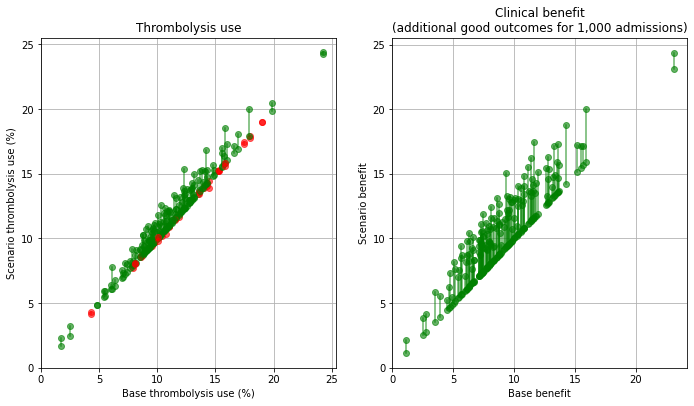
Plot effect of onset-known#
base_rx = key_results[key_results['scenario'] == 'base']['thrombolysis_rate'].values
scenario_rx = key_results[key_results['scenario'] == 'onset']['thrombolysis_rate'].values
base_benfit = key_results[key_results['scenario'] == 'base']['additional_good_outcomes_per_1000_patients'].values
scenario_benefit = key_results[key_results['scenario'] == 'onset']['additional_good_outcomes_per_1000_patients'].values
compare_plot(base_rx, scenario_rx, base_benfit, scenario_benefit,
'./output/hospitals_onset')
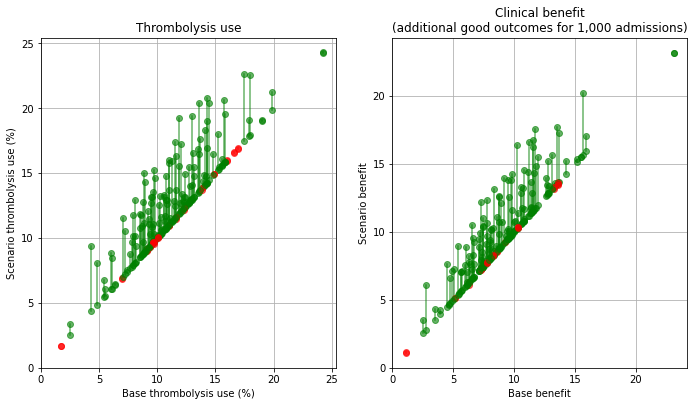
Plot effect of benchmark decisions#
base_rx = key_results[key_results['scenario'] == 'base']['thrombolysis_rate'].values
scenario_rx = key_results[key_results['scenario'] == 'benchmark']['thrombolysis_rate'].values
base_benfit = key_results[key_results['scenario'] == 'base']['additional_good_outcomes_per_1000_patients'].values
scenario_benefit = key_results[key_results['scenario'] == 'benchmark']['additional_good_outcomes_per_1000_patients'].values
compare_plot(base_rx, scenario_rx, base_benfit, scenario_benefit,
'./output/hospitals_benchmark')
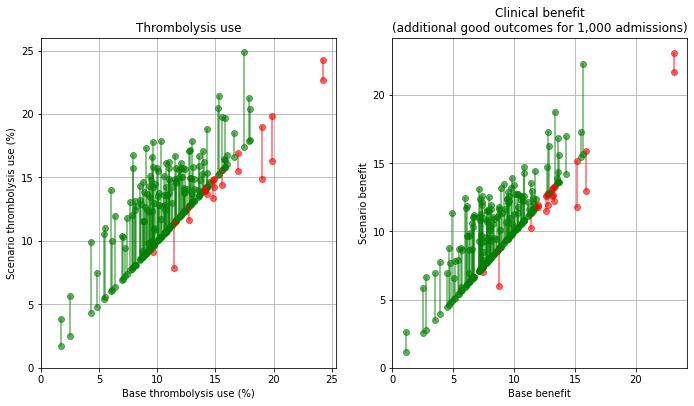
Plot effect of all changes#
base_rx = key_results[key_results['scenario'] == 'base']['thrombolysis_rate'].values
scenario_rx = key_results[key_results['scenario'] == 'speed_onset_benchmark']['thrombolysis_rate'].values
base_benfit = key_results[key_results['scenario'] == 'base']['additional_good_outcomes_per_1000_patients'].values
scenario_benefit = key_results[key_results['scenario'] == 'speed_onset_benchmark']['additional_good_outcomes_per_1000_patients'].values
compare_plot(base_rx, scenario_rx, base_benfit, scenario_benefit,
'./output/hospitals_speed_onset_benchmark')
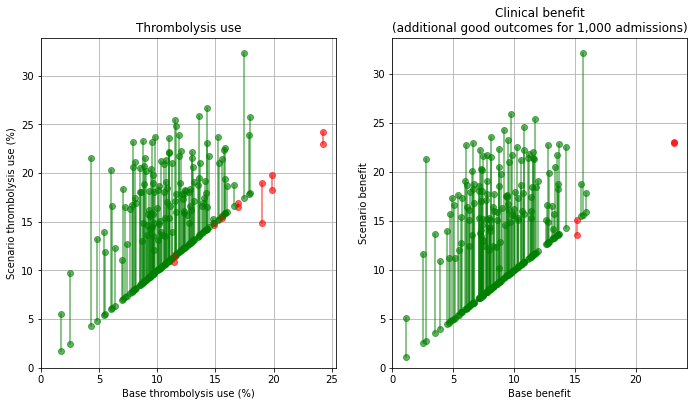
Histogram of shift in distribution of thrombolysis use and benefit#
base_rx = key_results[key_results['scenario'] == 'base']['thrombolysis_rate'].values
scenario_rx = key_results[key_results['scenario'] == 'speed_onset_benchmark']['thrombolysis_rate'].values
base_benfit = key_results[key_results['scenario'] == 'base']['additional_good_outcomes_per_1000_patients'].values
scenario_benefit = key_results[key_results['scenario'] == 'speed_onset_benchmark']['additional_good_outcomes_per_1000_patients'].values
fig, ax = plt.subplots(1,2,figsize=(10,6))
bins = np.arange(1,32)
ax[0].hist(base_rx, bins = bins, color='k', linewidth=2,
label='control', histtype='step')
ax[0].hist(scenario_rx, bins = bins, color='0.7', linewidth=2,
label='all in-hospital changes', histtype='stepfilled')
ax[0].grid()
ax[0].set_xlabel('Thrombolysis use (%)')
ax[0].set_ylabel('Hospital count')
ax[0].set_ylim(0,30)
ax[0].yaxis.set_major_locator(MultipleLocator(5))
ax[0].set_title('Thrombolysis use')
ax[0].legend()
ax[1].hist(base_benfit, bins = bins, color='k', linewidth=2,
label='control', histtype='step')
ax[1].hist(scenario_benefit, bins = bins, color='0.7', linewidth=2,
label='all in-hospital changes', histtype='stepfilled')
ax[1].grid()
ax[1].set_xlabel('Clincial benefit\n(additional good outcomes per 1000 admissions)')
ax[1].set_ylabel('Hospital count')
ax[1].set_ylim(0,26)
ax[1].yaxis.set_major_locator(MultipleLocator(5))
ax[1].set_title('Clincial benefit')
ax[1].legend()
plt.savefig('./output/histograms.jpg', dpi=300)
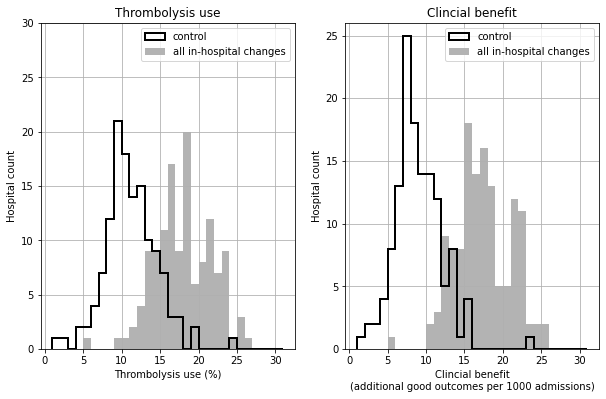
Find which change makes most difference in each hospital#
Best thrombolysis rate#
# Pivot results
results_pivot = (key_results[['thrombolysis_rate', 'scenario', 'stroke_team']].pivot(
index='stroke_team', columns='scenario'))
results_pivot = results_pivot['thrombolysis_rate']
# Limit to single changes
cols_to_drop = ['speed_benchmark', 'speed_onset', 'onset_benchmark', 'speed_onset_benchmark']
results_pivot.drop(cols_to_drop, axis=1, inplace=True)
# Find largest effect
best_result = results_pivot.idxmax(1)
# Count
best_result.value_counts()
benchmark 83
onset 39
speed 10
dtype: int64
Best outcomes#
# Pivot results
results_pivot = (key_results[['additional_good_outcomes_per_1000_patients',
'scenario', 'stroke_team']].pivot(index='stroke_team', columns='scenario'))
results_pivot = results_pivot['additional_good_outcomes_per_1000_patients']
# Limit to single changes
cols_to_drop = ['speed_benchmark', 'speed_onset', 'onset_benchmark', 'speed_onset_benchmark']
results_pivot.drop(cols_to_drop, axis=1, inplace=True)
# Find largest effect
best_result = results_pivot.idxmax(1)
# Count
best_result.value_counts()
benchmark 56
speed 49
onset 27
dtype: int64
Bar charts of individual changes at all hospitals#
Here we summarise the effect of individual changes at each hospital.
Note that actual combined changes will be more than additive, but these plots give an indication of what the most significant effects will be across all hospitals.
# Pivot results by scenario type
results_pivot = key_results.pivot(index='stroke_team', columns='scenario')
hosp_per_chart = np.ceil(results_pivot.shape[0]/2)
# Thrombolysis chart
fig, axs = plt.subplots(2,1, figsize=(12,12), sharey=True)
# 4 subplots
i=0
for ax in axs.flat:
# Get subgroup of data for plot
start = int(hosp_per_chart * i)
end = int(hosp_per_chart * (i + 1))
subgroup = results_pivot.iloc[start:end]
# Get effect of speed (avoid negatives)
speed = subgroup['thrombolysis_rate']['speed'] - subgroup['thrombolysis_rate']['base']
speed = list(map (lambda x: max(0,x), speed))
# Get effect of known onset (avoid negatives)
onset = subgroup['thrombolysis_rate']['onset'] - subgroup['thrombolysis_rate']['base']
onset = list(map (lambda x: max(0,x), onset))
# Get effect of decision (avoid negatives)
eligible = subgroup['thrombolysis_rate']['benchmark'] - subgroup['thrombolysis_rate']['base']
eligible = list(map (lambda x: max(0,x), eligible))
x = range(start, start + subgroup.shape[0])
ax.bar(x, speed, color='b', label = 'Speed')
ax.bar(x, onset, color='g', bottom = speed, label = 'Onset known')
ax.bar(x, eligible, color='r', bottom = np.array(speed) + np.array(onset),
label = 'Benchmark decision')
ax.legend()
ax.set_xlabel('Hospital')
ax.set_ylabel('Increase in thrombolysis use (percentage points)')
# Put y tick label son all charts
ax.yaxis.set_tick_params(which='both', labelbottom=True)
i += 1
plt.tight_layout(pad=2)
plt.savefig('./output/all_hosp_bar_thrombolysis.jpg', dpi=300)
plt.show()
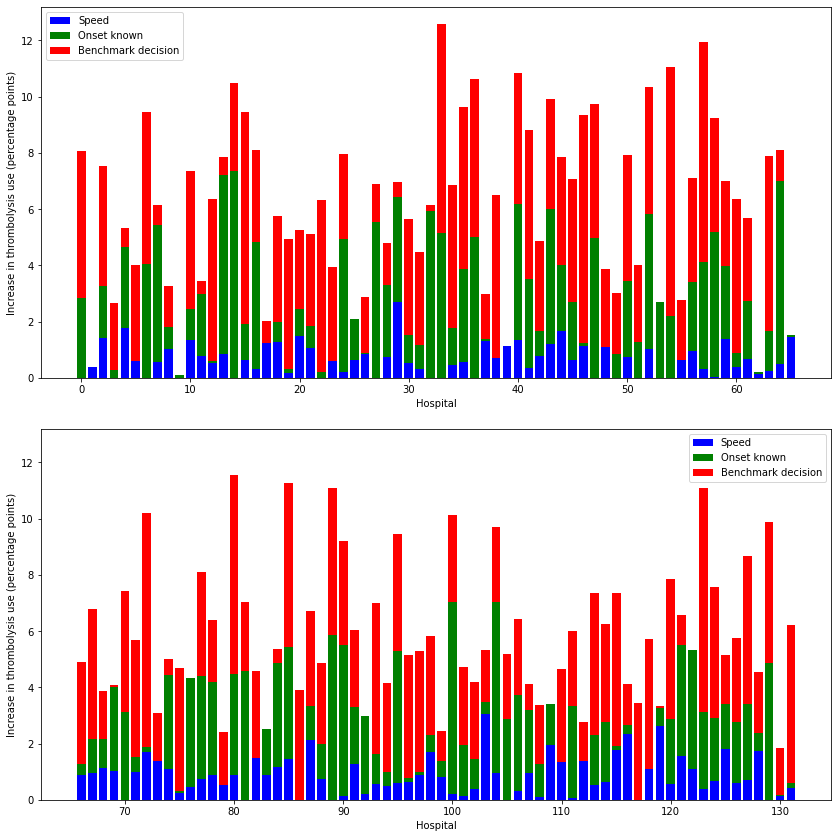
hosp_per_chart = np.ceil(results_pivot.shape[0]/2)
# Outcomes chart
fig, axs = plt.subplots(2,1, figsize=(12,12), sharey=True)
# 4 subplots
i=0
for ax in axs.flat:
# Get subgroup of data for plot
start = int(hosp_per_chart * i)
end = int(hosp_per_chart * (i + 1))
subgroup = results_pivot.iloc[start:end]
# Get effect of speed (avoid negatives)
speed = subgroup['additional_good_outcomes_per_1000_patients']['speed'] - \
subgroup['additional_good_outcomes_per_1000_patients']['base']
speed = list(map (lambda x: max(0,x), speed))
# Get effect of known onset (avoid negatives)
onset = subgroup['additional_good_outcomes_per_1000_patients']['onset'] - \
subgroup['additional_good_outcomes_per_1000_patients']['base']
onset = list(map (lambda x: max(0,x), onset))
# Get effect of decision (avoid negatives)
eligible = subgroup['additional_good_outcomes_per_1000_patients']['benchmark'] - \
subgroup['additional_good_outcomes_per_1000_patients']['base']
eligible = list(map (lambda x: max(0,x), eligible))
x = range(start, start + subgroup.shape[0])
ax.bar(x, speed, color='b', label = 'Speed')
ax.bar(x, onset, color='g', bottom = speed, label = 'Onset known')
ax.bar(x, eligible, color='r', bottom = np.array(speed) + np.array(onset),
label = 'Benchmark decision')
ax.legend()
ax.set_xlabel('Hospital')
ax.set_ylabel('Increase in good outcomes (per 1,000 admissions)')
# Put y tick label son all charts
ax.yaxis.set_tick_params(which='both', labelbottom=True)
i += 1
plt.tight_layout(pad=2)
plt.savefig('./output/all_hosp_bar_outcomes.jpg', dpi=300)
plt.show()
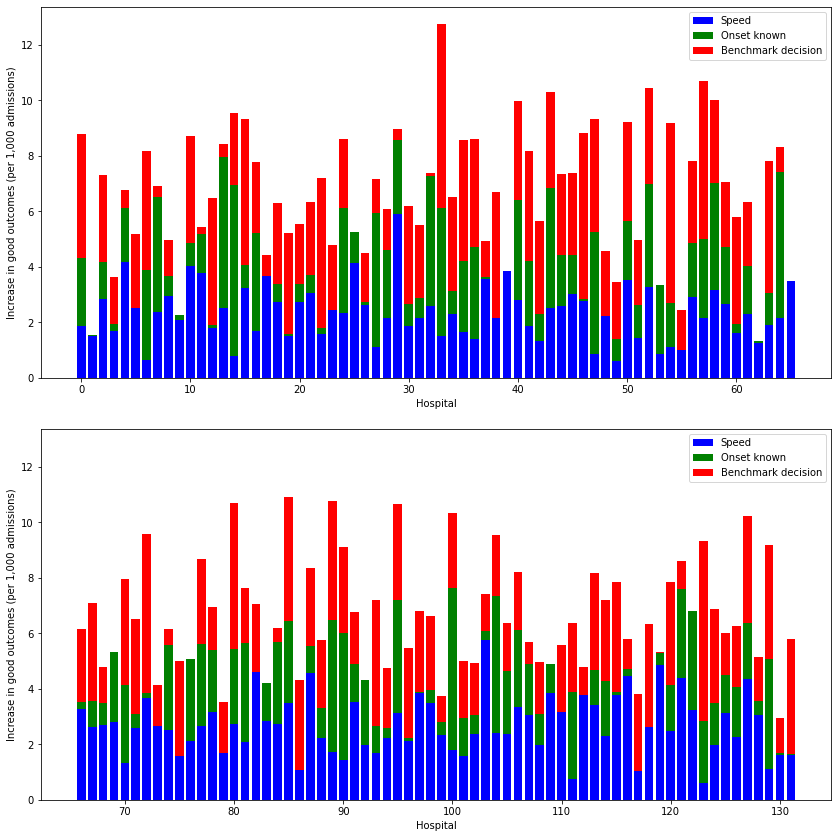
Results for individual hospitals#
We may plot more detailed results at an individual hospital level.
def plot_hospital(data, id):
hospital_data = data.iloc[id]
max_val = max(hospital_data['thrombolysis_rate'].max(),
hospital_data['additional_good_outcomes_per_1000_patients'].max())
max_val = 5 * int(max_val/5) + 5
team = hospital_data.name
# Sort results
df = pd.DataFrame()
df['thrombolysis_rate'] = hospital_data['thrombolysis_rate']
df['outcomes'] = hospital_data['additional_good_outcomes_per_1000_patients']
order = {'base': 1, 'speed': 2, 'onset': 3, 'benchmark': 4, 'speed_onset': 5,
'speed_benchmark': 6, 'onset_benchmark':7, 'speed_onset_benchmark': 8}
df_order = [order[x] for x in list(df.index)]
df['order'] = df_order
df.sort_values('order', inplace=True)
fig = plt.figure(figsize=(10,7))
ax1 = fig.add_subplot(121)
x = df['thrombolysis_rate'].index
y1 = df['thrombolysis_rate']
ax1.bar(x,y1)
plt.xticks(rotation=90)
ax1.set_title('Thrombolysis use (%)')
ax1.set_ylabel('Thrombolysis use (%)')
ax1.set_xlabel('Scenario')
ax1.set_ylim(0, max_val)
ax1.grid(axis = 'y')
ax2 = fig.add_subplot(122)
y1 = df['outcomes']
ax2.bar(x,y1, color='r')
plt.xticks(rotation=90)
ax2.set_title('Additional good outcomes\nper 1,000 admissions')
ax2.set_ylabel('Additional good outcomes\nper 1,000 admissions')
ax2.set_xlabel('Scenario')
ax2.set_ylim(0, max_val)
ax2.grid(axis = 'y')
plt.suptitle(f'Scenario results for team: {team}')
plt.tight_layout(pad=2)
plt.savefig(f'./output/hosp_results_{team}.jpg', dpi=300)
plt.show()
An example where speed makes most difference.
plot_hospital(results_pivot, 103)
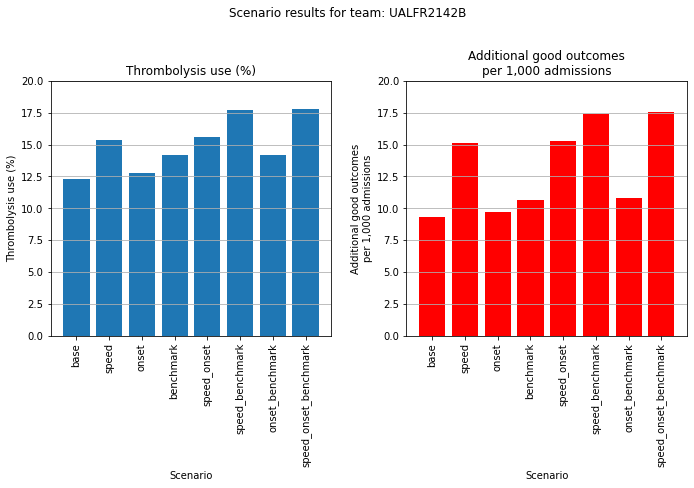
An example where determining stroke onset time makes most difference.
plot_hospital(results_pivot, 64)
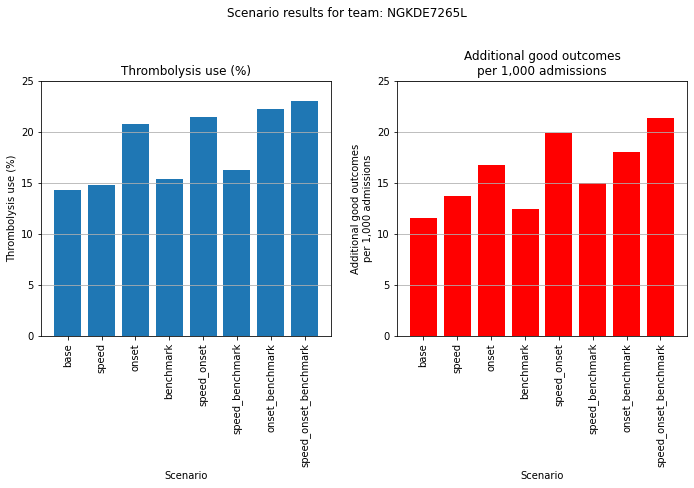
An example where applying benchmark decion-making makes most difference.
plot_hospital(results_pivot, 54)
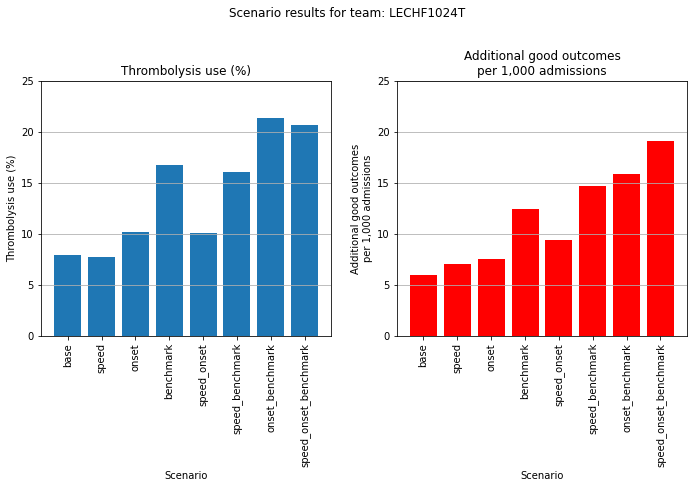
Observations#
The combined effect of the changes modelled were to increase thrombolysis use from 11.6% to 18.3% of all patients (57% increase), and to increase the number of thrombolysis-related good outcomes per 1,000 admissions from 9.4 to 17.6 (86% increase).
Overall the net improvements made to thrombolysis use were benchmark decisions > determining stroke onset time > speed improvement.
Overall the net improvements made to additional good outcomes were speed improvement > benchmark decisions > determining stroke onset time.
Speed improvement therefore had least effect on the proportion of patients receiving thrombolysis, but most effect on the the predicted outcomes. This is due to improving the speed of thrombolysis improving the outcomes for all patients, including those that would have received thrombolysis anyway (without speed improvement).
When asking the question “which single change makes most difference at each hospital?” then for thrombolysis the order is: benchmark decisions (83/132 hospitals), determining time of stroke onset (39/132), speed (10/132). For improvements in clinical outcome the order is benchmark decisions (56/132 hospitals), speed (49/132), and determining time of stroke onset (27/132).
Combining improvements to the pathway had a greater effect than any single change alone.
Even with all improvements, there would still be expected to be a significant inter-hospital variation in use of thrombolysis and, the benefit gained. With the modelled improvements there is a general improvement across hospitals, and not a significant reduction in inter-hospital variation. The remaining variation is due to variation in patient populations.
Charts may be readily produced for each hospitals showing the potential benefit of each process change individually or combined.